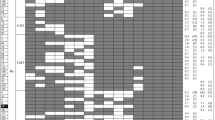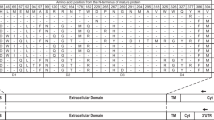Abstract
Natural killer (NK) and some T cells express killer cell immunoglobulin-like receptors (KIRs), which interact with HLA class I expressed by target cells and consequently regulate cytolytic activity. The number of KIR loci can vary and so a range of genetic profiles is observed. We have determined the KIR genetic profiles from one African (n = 62) and two South Asian (n = 108, n = 78) populations. Several of the KIRs are present at significantly different frequencies between the two major ethnic groups (eg KIR2DS4 gene frequency 0.82 African, 0.47 S Asian. Pc < 1 × 10−6) and this is due to uneven distribution of two KIR haplotype families ‘A’ and ‘B’. All three populations described here displayed a greater degree of diversity of KIR genetic profiles than other populations investigated, which indicates further complexity of underlying haplotypes; in this respect we describe two individuals who appear homozygous for a large deletion including the previously ubiquitous 2DL4. We have also reanalysed three populations that we studied previously, for the presence of a KIR which is now known to be an indicator of the ‘B’ haplotype. South Asians had the highest overall frequencies of all KIR loci characteristic of ‘B’ haplotypes (Pc < 0.0001 to < 0.004). Furthermore, gene frequency independent deviances in the linkage disequilibrium were apparent between populations.
This is a preview of subscription content, access via your institution
Access options
Subscribe to this journal
Receive 6 digital issues and online access to articles
$119.00 per year
only $19.83 per issue
Buy this article
- Purchase on Springer Link
- Instant access to full article PDF
Prices may be subject to local taxes which are calculated during checkout

Similar content being viewed by others
References
Lanier LL . NK cell receptors Annu Rev Immunol 1998 16: 359–393
Raulet DH, Vance RE, McMahon CW . Regulation of the natural killer cell receptor repertoire Annu Rev Immunol 2001 19: 291–330
Moretta A, Bottino C, Vitale M et al. Activating receptors and coreceptors involved in human natural killer cell-mediated cytolysis Annu Rev Immunol 2001 19: 197–223
Dukers DF, Vermeer MH, Jaspars LH et al. Expression of killer cell inhibitory receptors is restricted to true NK cell lymphomas and a subset of intestinal enteropathy-type T cell lymphomas with a cytotoxic phenotype J Clin Pathol 2001 54: 224–228
Bagot M, Moretta A, Sivori S et al. CD4(+) cutaneous T-cell lymphoma cells express the p140-killer cell immunoglobulin-like receptor Blood 2001 97: 1388–1391
Jabri B, de Serre NP, Cellier C et al. Selective expansion of intraepithelial lymphocytes expressing the HLA-E-specific natural killer receptor CD94 in celiac disease Gastroenterology 2000 118: 867–879
Warrington KJ, Takemura S, Goronzy JJ, Weyand CM . CD4+, CD28− T cells in rheumatoid arthritis patients combine features of the innate and adaptive immune systems Arthritis Rheum 2001 44: 13–20
Yen JH, Moore BE, Nakajima T et al. Major histocompatibility complex class I-recognizing receptors are disease risk genes in rheumatoid arthritis J Exp Med 2001 193: 1159–1167
Ruggeri L, Capanni M, Casucci M et al. Role of natural killer cell alloreactivity in HLA-mismatched hematopoietic stem cell transplantation Blood 1999 94: 333–339
Young NT, Uhrberg M, Phillips JH, Lanier LL, Parham P . Differential expression of leukocyte receptor complex-encoded Ig-like receptors correlates with the transition from effector to memory CTL J Immunol 2001 166: 3933–3941
Uhrberg M, Valiante NM, Shum BP et al. Human diversity in killer cell inhibitory receptor genes Immunity 1997 7: 753–763
Witt CS, Dewing C, Sayer DC, Uhrberg M, Parham P, Christiansen FT . Population frequencies and putative haplotypes of the killer cell immunoglobulin-like receptor sequences and evidence for recombination Transplantation 1999 68: 1784–1789
Crum KA, Logue SE, Curran MD, Middleton D . Development of a PCR-SSOP approach capable of defining the natural killer cell inhibitory receptor (KIR) gene sequence repertoires Tissue Antigens 2000 56: 313–326
Norman PJ, Stephens HAF, Verity DH, Chandanayingyong D, Vaughan RW . Distribution of natural killer cell immunoglobulin-like receptor sequences in three ethnic groups Immunogenetics 2001 52: 195–205
Selvakumar A, Steffens U, Dupont B . NK cell receptor gene of the KIR family with two IG domains but highest homology to KIR receptors with three IG domains Tissue Antigens 1996 48: 285–294
Vilches C, Rajalingam R, Uhrberg M, Gardiner CM, Young NT, Parham P . KIR2DL5, a novel killer-cell receptor with a D0–D2 configuration of Ig-like domains J Immunol 2000 164: 5797–5804
Gardiner CM, Guethlein LA, Shilling HG et al. Different NK cell surface phenotypes defined by the DX9 antibody are due to KIR3DL1 gene polymorphism J Immunol 2001 166: 2992–3001
Brouwer DA, Mulder H, Fokkens B, Ramsewak S, Muskiet FA, Ramdath DD . Cord blood apolipoprotein-E genotype distribution and plasma lipid indices in newborns of different ethnicity Annals Hum Biol 2000 27: 367–375
Hameed K, Bowman S, Kondeatis E, Vaughan R, Gibson T . The association of HLA-DRB genes and the shared epitope with rheumatoid arthritis in Pakistan Br J Rheumatol 1997 36: 1184–1188
Vilches C, Pando MJ, Parham P . Genes encoding human killer-cell Ig-like receptors with D1 and D2 extracellular domains all contain untranslated pseudoexons encoding a third Ig-like domain Immunogenetics 2000 51: 639–646
Toneva M, Lepage V, Lafay G et al. Genomic diversity if natural killer cell receptor genes in three populations Tissue Antigens 2001 57: 358–362
Wilson MJ, Torkar M, Haude A et al. Plasticity in the organization and sequences of human KIR/ILT gene families Proc Natl Acad Sci USA 2000 97: 4778–4783
Reich D, Cargill M, Bolk S et al. Linkage disequilibrium in the human genome Nature 2001 411: 199–204
Wende H, Colonna M, Ziegler A, Volz A . Organisation of the leukocyte receptor cluster (LRC) on human chromosome 19q13.4 Mammalian Genome 1999 10: 154–160
Wende H, Volz A, Ziegler A . Extensive gene duplications and large inversion characterize the human leukocyte receptor cluster Immunogenetics 2000 51: 703–713
Rajagopalan S, Long EO . A human histocompatibility leukocyte antigen (HLA)-G-specific receptor expressed on all natural killer cells [published erratum appears in J Exp Med 2000 Jun 5; 191(11): following 2027] J Exp Med 1999 189: 1093–1100
Ponte M, Cantoni C, Biassoni R et al. Inhibitory receptors sensing HLA-G1 molecules in pregnancy: decidua-associated natural killer cells express LIR-1 and CD94/NKG2A and acquire p49, an HLA-G1-specific receptor Proc Natl Acad Sci USA 1999 96: 5674–5679
Rajalingam R, Hong M, Adams E, Shum B, Guethlein L, Parham P . Short KIR haplotypes in pygmy chimpanzee (Bonobo) resemble the conserved framework of diverse human KIR haplotypes J Exp Med 2001 193: 135–146
Shilling HG, Lienert-Weidenbach K, Valiante NM, Uhrberg M, Parham P . Evidence for recombination as a mechanism for KIR diversification Immunogenetics 1998 48: 413–416
Rajalingam R, Gardiner CM, Canavez F, Vilches C, Parham P . Identification of seventeen novel KIR variants: fourteen of them from two non-Caucasian donors Tissue Antigens 2001 57: 22–31
Everitt B . The Analysis of Contingency Tables. 2nd edn. Chapman and Hall: 1994
Acknowledgements
We are very grateful to the staff at Mount Hope Women’s Hospital in Trinidad and the Aga Khan University Hospital of Karachi. We thank the members of Stanford University Structural Biology department for their comments. The work reported here was performed in accordance with all appropriate regulations.
Author information
Authors and Affiliations
Corresponding author
Additional information
We thank the University of West Indies, St Augustine Campus Research and Publications committee and Caribbean Health Research Council for funding the Trinidad sample collection. C V F Carrington's visit to Guy's Hospital was initially supported by a Rhodes Trust grant. Ethical approval was obtained from the Ethics Committee of the Faculty of Medical Sciences, University of West Indies.
Rights and permissions
About this article
Cite this article
Norman, P., Carrington, C., Byng, M. et al. Natural killer cell immunoglobulin-like receptor (KIR) locus profiles in African and South Asian populations. Genes Immun 3, 86–95 (2002). https://doi.org/10.1038/sj.gene.6363836
Received:
Revised:
Accepted:
Published:
Issue Date:
DOI: https://doi.org/10.1038/sj.gene.6363836
Keywords
This article is cited by
-
KIR gene presence/absence polymorphisms and global diversity in the Kirgiz ethnic minority and populations distributed worldwide
Molecular Biology Reports (2019)
-
Killer-cell Immunoglobulin-like Receptor gene linkage and copy number variation analysis by droplet digital PCR
Genome Medicine (2014)
-
Two New Cases of KIR3DP1, KIR2DL4-Negative Genotypes, One of which is also Lacking KIR3DL2
Archivum Immunologiae et Therapiae Experimentalis (2014)
-
Recombinant structures expand and contract inter and intragenic diversification at the KIR locus
BMC Genomics (2013)
-
Killer cell immunoglobulin-like receptor (KIR) genes and their HLA-C ligands in a Ugandan population
Immunogenetics (2013)



